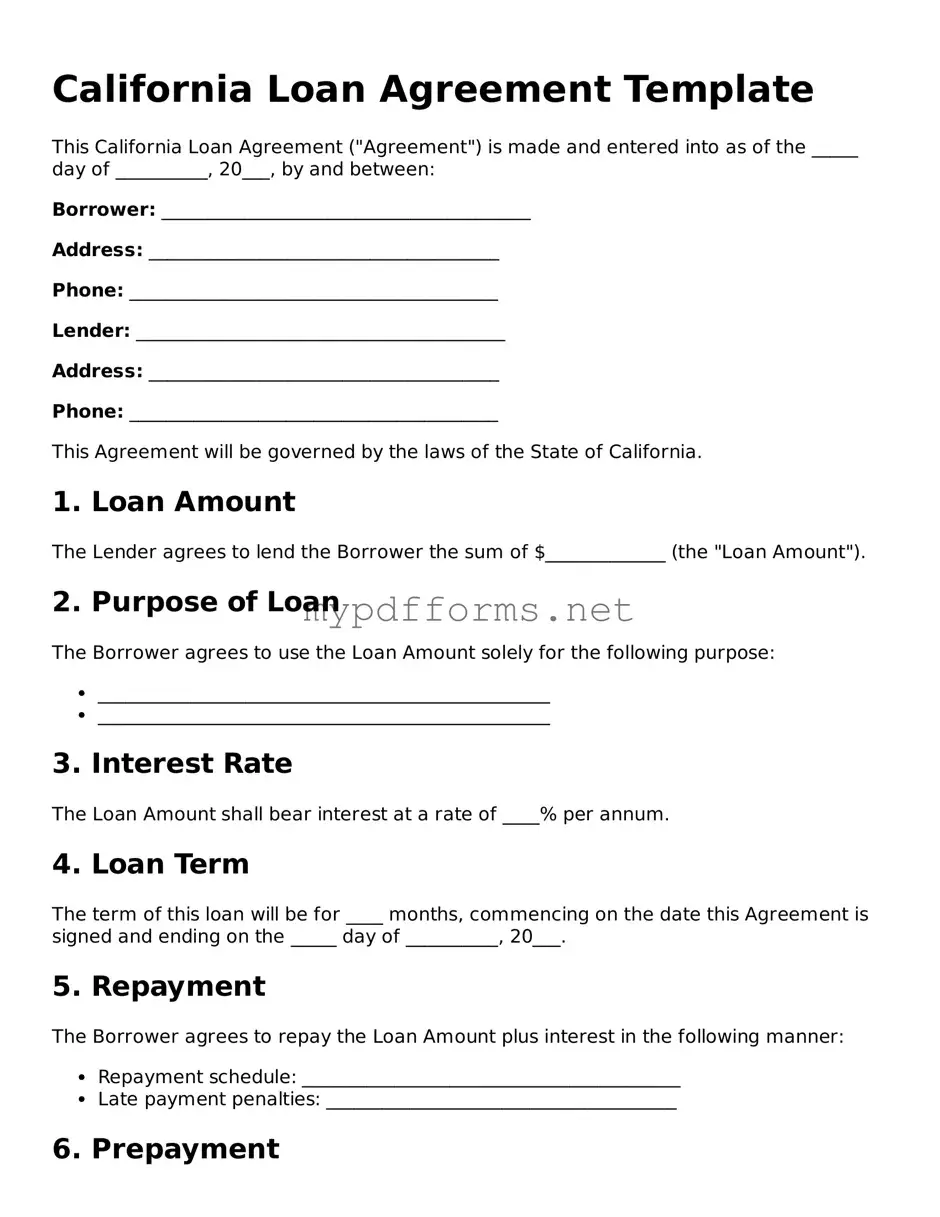The California Loan Agreement form shares similarities with a Promissory Note. Both documents outline the terms of a loan, including the amount borrowed, interest rates, and repayment schedules. While a Loan Agreement is more comprehensive, detailing the rights and obligations of both parties, a Promissory Note is typically a simpler document that primarily focuses on the borrower's promise to repay the loan. Both documents serve as legal evidence of the loan arrangement and can be enforced in court if necessary.
Another document similar to the California Loan Agreement is the Mortgage Agreement. While a Loan Agreement can be unsecured, a Mortgage Agreement specifically secures the loan with real property. This means that if the borrower defaults, the lender has the right to foreclose on the property. Both documents include terms regarding repayment and may outline penalties for late payments, but the Mortgage Agreement also includes specific provisions related to the property being used as collateral.
The California Loan Agreement is also akin to a Security Agreement. In both documents, the borrower agrees to provide collateral to secure the loan. A Security Agreement, however, is often used for personal property rather than real estate. It details the specific collateral and the rights of the lender in the event of default. While both documents aim to protect the lender's interests, the Security Agreement is more focused on the specific assets pledged as security.
A similar document is the Loan Application. This document is typically completed by the borrower to provide the lender with necessary information about their financial situation. While the Loan Agreement finalizes the terms of the loan, the Loan Application initiates the lending process. Both documents are essential in establishing the lender-borrower relationship, but they serve different purposes within that relationship.
The California Loan Agreement can also be compared to a Lease Agreement, particularly when the loan is related to rental property. Both documents outline terms and conditions regarding the use of property, including payment amounts and timelines. However, a Lease Agreement specifically pertains to the rental of property, while a Loan Agreement is focused on the borrowing of funds. Both documents require clear communication of obligations to prevent disputes.
Another related document is the Loan Modification Agreement. This document is used when the terms of an existing loan need to be changed, such as adjusting interest rates or extending repayment periods. While the California Loan Agreement sets the original terms, a Loan Modification Agreement serves to update those terms to better suit the needs of both the borrower and lender. Both documents require mutual consent and are legally binding.
Understanding various loan agreements is essential for both lenders and borrowers to navigate the complexities of financial transactions. For example, the motorcyclebillofsale.com/free-georgia-motorcycle-bill-of-sale is a critical legal document that ensures the proper transfer of motorcycle ownership, similar to how loan agreements clarify the expectations between lending parties. Each type of agreement serves a unique purpose, emphasizing the importance of formalizing financial exchanges to safeguard rights and responsibilities.
The California Loan Agreement is also similar to a Forbearance Agreement. This document is utilized when a borrower is struggling to make payments and requests temporary relief from their obligations. Both agreements require the lender's approval and outline new terms for repayment. However, a Forbearance Agreement is specifically focused on providing short-term relief, whereas the Loan Agreement establishes the long-term terms of the loan.
A similar document is the Loan Repayment Plan. This plan details how a borrower will repay their loan over time, including specific payment amounts and due dates. While the Loan Agreement provides the overall framework for the loan, the Loan Repayment Plan breaks down the repayment process into manageable steps. Both documents aim to ensure that the borrower understands their obligations and can fulfill them.
Lastly, the California Loan Agreement resembles a Debt Settlement Agreement. This document is used when a borrower negotiates with a lender to settle a debt for less than the total amount owed. Both agreements involve discussions between the borrower and lender, but a Debt Settlement Agreement typically occurs after a borrower has defaulted or is at risk of defaulting. While the Loan Agreement is proactive in establishing terms, the Debt Settlement Agreement is reactive, often arising from financial distress.
